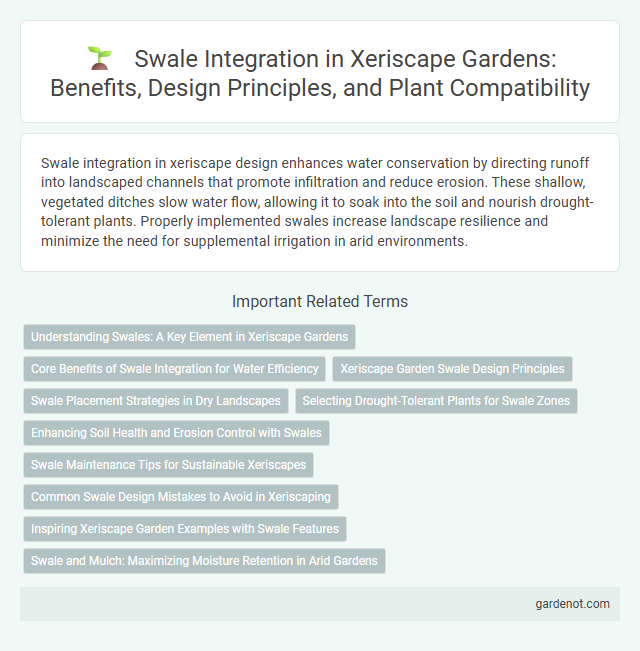Swale integration in xeriscape design enhances water conservation by directing runoff into landscaped channels that promote infiltration and reduce erosion. These shallow, vegetated ditches slow water flow, allowing it to soak into the soil and nourish drought-tolerant plants. Properly implemented swales increase landscape resilience and minimize the need for supplemental irrigation in arid environments.
Understanding Swales: A Key Element in Xeriscape Gardens
Swales are shallow, vegetated channels designed to manage water runoff efficiently in xeriscape gardens, minimizing erosion and promoting groundwater recharge. By directing rainwater to planted areas, swales enhance soil moisture retention, reducing the need for supplemental irrigation and supporting drought-tolerant plant growth. Integrating swales into xeriscaping maximizes water conservation while maintaining landscape health and aesthetic appeal.
Core Benefits of Swale Integration for Water Efficiency
Swale integration in xeriscaping significantly enhances water efficiency by promoting effective stormwater management and natural groundwater recharge. These shallow, vegetated channels reduce runoff, increase soil infiltration, and prevent erosion, contributing to sustainable landscape irrigation. By capturing rainwater on-site, swales minimize reliance on supplemental watering, conserving valuable water resources in arid environments.
Xeriscape Garden Swale Design Principles
Xeriscape garden swale design principles emphasize efficient water management by creating shallow, vegetated channels that capture and infiltrate runoff, reducing erosion and promoting groundwater recharge. The swales are strategically integrated into the landscape to direct water flow toward drought-tolerant plants, minimizing irrigation needs and enhancing soil moisture retention. Incorporating native, drought-resistant vegetation within swales supports sustainable xeriscape ecosystems while improving landscape aesthetics and resilience.
Swale Placement Strategies in Dry Landscapes
Swale placement in dry landscapes is critical for maximizing water retention and preventing soil erosion by directing runoff to strategic planting areas. Positioning swales along contour lines on gentle slopes enhances infiltration and supports xeriscape vegetation by maintaining consistent moisture levels. Integrating swales near drought-tolerant plant clusters optimizes water use efficiency and promotes sustainable landscaping in arid environments.
Selecting Drought-Tolerant Plants for Swale Zones
Selecting drought-tolerant plants for swale zones enhances water efficiency and soil stabilization in xeriscape design. Native species such as lavender, yarrow, and desert willow thrive in low-water conditions while promoting infiltration and reducing runoff. Incorporating deep-rooted grasses like blue grama and buffalo grass further supports erosion control and sustains the swale's infiltration capacity.
Enhancing Soil Health and Erosion Control with Swales
Swale integration in xeriscaping significantly enhances soil health by promoting water infiltration and reducing surface runoff, which minimizes soil erosion. These shallow, vegetated channels slow down water flow, allowing sediments and nutrients to settle and improve soil fertility naturally. Incorporating swales effectively stabilizes the landscape and supports drought-resistant plant growth through improved moisture retention and soil structure.
Swale Maintenance Tips for Sustainable Xeriscapes
Maintaining swales in xeriscape designs requires regular inspection to prevent erosion and ensure proper water flow, promoting soil moisture retention and plant health. Removing debris and controlling invasive weeds helps sustain the swale's function as an efficient rainwater harvesting feature, reducing irrigation needs. Periodic mulching and reseeding with native drought-tolerant plants enhance soil stability and biodiversity within the xeriscape landscape.
Common Swale Design Mistakes to Avoid in Xeriscaping
Common swale design mistakes to avoid in xeriscaping include improper grading that leads to poor water retention or unintended erosion, which undermines the swale's ability to capture and direct runoff effectively. Neglecting native, drought-tolerant plant selection can reduce the swale's filtration capacity and increase maintenance requirements. Failing to incorporate appropriate overflow outlets may cause waterlogging or damage to downstream areas, compromising the sustainability of the xeriscape system.
Inspiring Xeriscape Garden Examples with Swale Features
Inspiring xeriscape garden examples showcase swale features that effectively manage stormwater while enhancing landscape aesthetics. Swales create natural water channels that promote soil infiltration, reduce erosion, and support drought-resistant plantings common in xeriscaping. These integrated swale designs optimize water conservation, demonstrating sustainable landscaping practices in arid environments.
Swale and Mulch: Maximizing Moisture Retention in Arid Gardens
Swale integration in xeriscape design enhances moisture capture by channeling runoff directly into planting beds, minimizing water loss in arid gardens. Applying mulch over swales significantly improves soil moisture retention by reducing evaporation and moderating soil temperature. Combining swales with organic mulch creates a synergistic effect, promoting healthier drought-tolerant plants and sustainable water use in xeriscaping.
Swale integration Infographic

 gardenot.com
gardenot.com